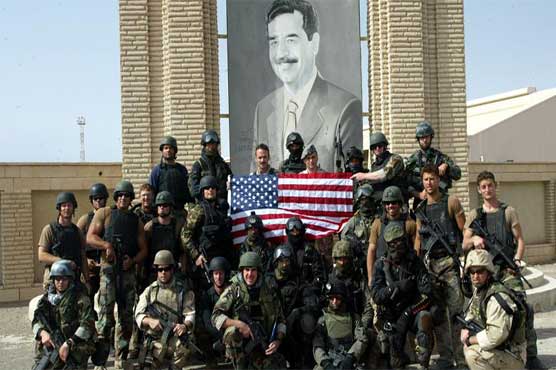US-Iraq relations since 2003

US inspector says no weapons of mass destruction have been found in Iraq
(AFP) - President Donald Trump s surprise troop visit to Iraq triggered criticism in the country still deeply divided over US influence.
Here are key dates since the US-led invasion in 2003:
Invasion
On March 20, 2003, a US-led invasion of Saddam Hussein s Iraq is launched after claims his regime is harbouring weapons of mass destruction.
On April 9, US forces take control of Baghdad, where a large statue of Saddam is symbolically toppled by an American tank, backed by a crowd of Iraqis.
US President George W. Bush announces the end of major combat operations on May 1, but says the war against terrorism continues.
Civil administrator Paul Bremer forbids all high-ranking Baath party officials from holding public sector jobs. He announces the dissolution of the Iraqi military, the information ministry and other state security organisations.
On October 2, a US inspector says no weapons of mass destruction have been found in Iraq.
On December 13 Saddam is captured in Tikrit, to the north of Baghdad, after nine months on the run. He is hanged three years later.
The broadcast in April 2004 of images of torture and other abuse of Iraqi prisoners at the Abu Ghraib US military prison shocks the world.
Insurgency, sectarian conflict
In November 2004, more than 10,000 American and 2,000 Iraqi soldiers attack Fallujah, 60 kilometres (37 miles) to the west of the capital.
The flashpoint Sunni city had become a symbol of resistance to the foreign presence after the lynching of four Americans in late March. The burned bodies of two of them had been put on show by an angry crowd.
In February 2006, Al-Qaeda-linked jihadists blow up one of the country s main Shiite shrines, in Samarra, sparking a wave of sectarian killings which leaves tens of thousands dead and lasts until 2008.
In January 2007 President Bush, brushing aside demands at home for a withdrawal, announces a surge of 30,000 troops, bringing total force numbers to 165,000. He argues the surge is needed to help the embattled Iraqi government bring the situation under control.
American soldiers depart
On April 7, 2009, new President Barack Obama who had fiercely opposed the war in Iraq, visits Baghdad, several months after his inauguration.
On December 18, 2011, the last American soldiers depart Iraq, leaving the country mired in a severe political crisis.
Between 2003 and 2011 more than 100,000 civilians have been killed, according to the Iraq Body Count database. The United States has lost nearly 4,500 troops.
Fighting the jihadists
In January 2014 jihadists from the Islamic State of Iraq and the Levant (ISIL), later known as the Islamic State group, capture the city of Fallujah and parts of Ramadi. They seize second city Mosul and Sunni Arab areas bordering the Kurdistan region in June.
By the end of 2014, they hold one-third of oil-rich Iraq.
In August 2014 Prime Minister Nuri al-Maliki, accused of having sown the seeds of chaos by sidelining the Sunnis, is ousted and replaced by Haider al-Abadi.
The United States intervenes directly in Iraq for the first time since its forces withdrew in 2011, bombarding jihadist positions which threaten Iraqi Kurdistan and thousands of Christians and Yazidis.
With the help of a US-led international coalition, Iraqi forces drive the IS from all urban centres after a brutal military campaign.
In December 2017 Abadi declares the "end of the war" against IS.
Surprise Trump visit
On December 26, 2018, Trump makes a lightning visit of several hours to meet US soldiers in Iraq.
But the visit comes under criticism in the country. The Iraqi government says there were no face-to-face talks between Trump and Iraqi Prime Minister Adel Abdel Mahdi due to "differing views on how to organise the meeting".
The two leaders instead spoke over the phone, it added.

